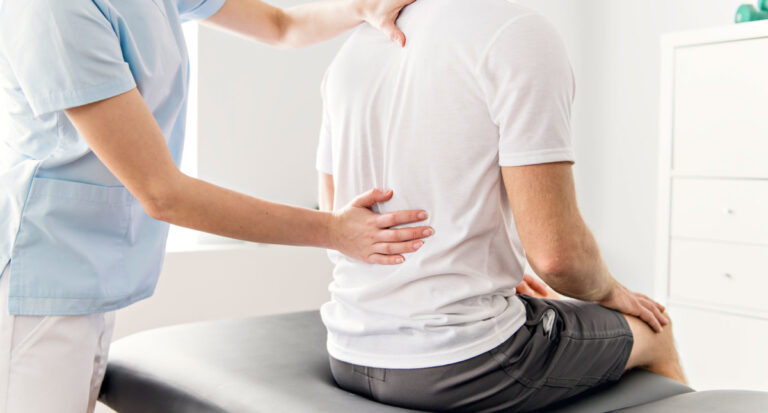Authored by Dr. Sheetal Deo, specializing in Physical Medicine & Rehabilitation
Welcome to our insightful exploration into the world of lumbar back pain. If you’re reading this, you might be among the millions worldwide who experience this common yet often misunderstood condition. Our goal is to shed light on lumbar back pain, diving deep into the realms of posture and ergonomics, all while simplifying the science behind it. Whether you’re seeking knowledge or solutions, this blog is your starting point.
The Lumbar Region: A Crucial Player in Back Pain
The lumbar spine, or lower back, is a complex structure of interconnecting bones, joints, nerves, ligaments, and muscles, all working together to provide support, strength, and flexibility. However, this intricate design is also susceptible to injury and pain.
Statistics and Facts
Did you know that back pain is one of the most common reasons for missed work? According to the American Chiropractic Association, approximately 80% of the population will experience back pain at some point in their lives. The Global Burden of Disease Study (2017) further highlights that low back pain is the leading cause of disability worldwide.
Unraveling the Causes of Lumbar Back Pain
Back pain, particularly in the lumbar region, can be attributed to a variety of factors. Common causes include:
- Muscle or ligament strain: Repeated heavy lifting or a sudden awkward movement can strain back muscles and spinal ligaments.
- Bulging or ruptured disks: Disks act as cushions between the bones (vertebrae) in your spine. The soft material inside a disk can bulge or rupture and press on a nerve, causing pain.
- Arthritis: Osteoarthritis can affect the lower back. In some cases, arthritis in the spine can lead to a narrowing of the space around the spinal cord, a condition called spinal stenosis. Interestingly, this cause of back pain is not limited to the elderly.
- Skeletal irregularities: A condition like scoliosis, a curvature of the spine, can lead to back pain, generally more likely if the scoliosis is severe.
Posture and Ergonomics: The Silent Culprits
Poor posture and non-ergonomic practices are significant contributors to back pain. A study published in the Journal of Back and Musculoskeletal Rehabilitation found that incorrect posture while sitting and standing can lead to increased strain on the lumbar region. In post-pandemic times with a drastic increase in “work from home” options, ergonomics has played an even larger part in attributing to back pain.
Improving Posture and Ergonomics
To combat this, consider the following tips:
- Mind Your Posture: Whether standing or sitting, maintaining a neutral pelvic position is crucial. Engaging the core is another key element in sustaining proper posture.
- Ergonomic Workstations: Ensure that your workstation is set up to support your back correctly. The top of your monitor should be at eye level, and your chairback should support the curve formed by your lower spine. Angles formed by your knees,hips, and elbows are also key factors.
- Take Regular Breaks: Frequent breaks from sitting can reduce the pressure on your lumbar spine. Setting alarms on your phone to remind you to stand and stretch can be very effective here.
When to Seek Help
While home remedies and proper ergonomics can alleviate simpler causes of back pain, it’s essential to recognize when to seek professional help. If you experience the following, consult a physician:
- Persistent or worsening pain
- Pain that effects your activities of daily living, limits your ability to live an active lifestyle, or inhibits your ability to sleep pain-free
- Pain that radiates down your leg
- Pain accompanied by numbness, tingling, or weakness
Conclusion: A Journey to Relief
Back pain, especially in the lumbar region, can be a complex condition influenced by various factors like posture and ergonomics. Understanding these elements and implementing changes can significantly impact your comfort and overall quality of life.
If you’re struggling with back pain and need expert care, our Physical Medicine & Rehabilitation team is here to help. With a focus on comprehensive, patient-centered treatment plans, and obtaining pertinent diagnostic studies where needed, we’re dedicated to guiding you on your journey to relief and better health.
References:
- American Chiropractic Association. (n.d.). Back Pain Facts and Statistics. Retrieved from ACA Website
- Global Burden of Disease Study 2017. (2018). The Lancet. Retrieved from The Lancet Website
- Journal of Back and Musculoskeletal Rehabilitation. (2017). The Impact of Posture on Back Pain. Retrieved from Journal Website
For more information or to schedule a consultation, please contact Sheetal Deo Medical P.C. at 212-596-4360 or www.DrSheetalDDeo.com






